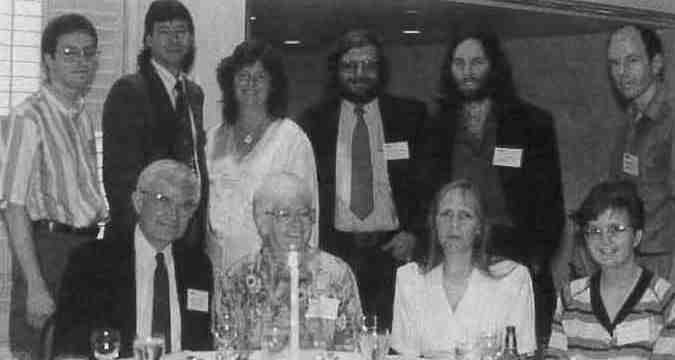


Awards and prizes
Awards, Appointments and Elections
Industrial Crystallography Award
The Industrial Crystallography Award of the British Crystallographic Association was presented to Peter Salt at the November 1995 meeting. Dr Salt started his career at the Rothamstead Experimental Station, Harpenden, conducting a soil survey of England with Brown, of clay minerals fame. In 1968 he joined ECC to set up X-ray fluorescent facilities and in 1975 was responsible for the development of automated X-ray Diffraction (XRD) there and its application to quantitative clay minerals analysis. Due to his knowledge of crystalline silica, his advice was sought when the Health and Safety Executive standardized dust analysis. When it was reported that such amounts could be a severe health hazard, Salt demonstrated the feasibility of measuring trace amounts of the carcinogen silica. Salt's modest manner cannot conceal the depth of his knowledge and experience.
D. J. DysonAppointments
University of Georgia, USA
The Department of Biochemistry and Molecular Biology of the University of Georgia, USA is pleased to announce the appointment of Dr B. C. Wang as Professor and Georgia Research Alliance Eminent Scholar in Structural Biology (protein crystallography). Professor Wang and his colleague, Dr John Rose, have established a crystallography laboratory in the Life Sciences Building.
 Michael Hart, new Chairman of the US National Synchrotron Light Source, modeling specially designed anti radiation gear, talks with Håkon Hope about his new animals rights group.
Michael Hart, new Chairman of the US National Synchrotron Light Source, modeling specially designed anti radiation gear, talks with Håkon Hope about his new animals rights group.
National Synchrotron Light Source
Dr Michael Hart was appointed Chairman of the US National Synchrotron Light Source in Upton, NY, USA in September 1995. Hart, a member of the Executive Committee of the IUCr, was a Professor of Physics at the University of Manchester and Science Program Coordinator of the Daresbury Lab. He has had extensive experience with synchrotron sources in the US and Europe and is well known for his many contributions to the theory and instrumentation of diffraction physics with increased emphasis on synchrotron radiation. He is a Fellow of the Royal Society and recipient of the ACA's Warren Award.
Lasker Award
 Don Wiley, recipient of a 1995 Lasker Award.
Don Wiley, recipient of a 1995 Lasker Award.
Don Wiley, Howard Hughes Medical Inst., U. of Harvard, received a 1995 Lasker Award for his contributions to understanding how the immune system works. Wiley's crystallographic studies of the major histocompatability complexes with peptide fragments have brought to light many aspects of the recognition process. The Lasker Awards have often been called the American Nobel Prizes because 52 of the 275 winners have gone on to win Nobels. Dr Wiley will deliver a keynote address at the XVII Congress and General Assembly of the IUCr in Seattle.
Feynman Prize
 Ned Seeman (standing third from right) with friends at the ACA banquet in Atlanta (1994). Seated (L to R): W. V. Wright, A. Wright. P. Vanderhoff-Hanover, L. A. Lipscomb. Standing (L to R): S. Schroeder, B. Finzel, P. Fitzgerald, N. Seeman, L. Brammer, S. Henderson. Not pictured: Ned's white gym shoes.
Ned Seeman (standing third from right) with friends at the ACA banquet in Atlanta (1994). Seated (L to R): W. V. Wright, A. Wright. P. Vanderhoff-Hanover, L. A. Lipscomb. Standing (L to R): S. Schroeder, B. Finzel, P. Fitzgerald, N. Seeman, L. Brammer, S. Henderson. Not pictured: Ned's white gym shoes.
The Feynman Prize for 1995 was awarded to Nadrian C. Seeman, New York U. The $10,000 award honors the scientist whose recent work has most advanced molecular nanotechnology. The prize was presented to Dr Seeman in November 1995 at the Fourth Foresight Conference on Molecular Nanotechnology in Palo Alto, California. Dr Seeman is Organizer and Chairman of a microsymposium on Crystal Growth at the XVII Congress in Seattle.
Crystallographers Elected
To the US National Academy of Sciences
- Member: Gregory A. Petsko, Lucille P. Markey Professor, Rosenstiel Basic Medical Science Center, Brandeis U., Waltham, MA, USA.
- Foreign Associate: Nobel Laureate Robert Huber, head of dept., Max Planck Inst. for Biochemistry, Munich, Germany.
To the Royal Society 1995 Fellows
- Julia S. Higgens, U. of London, distinguished for her studies of the molecular structure of polymers, used a range of techniques including neutron scattering, which she has developed and applied in novel and imaginative ways.
- Frank M. Leslie, U. of Strathclyde, has used mathematical models to study liquid crystals.
- Colin G. Windsor, National NDT Center, Oxfordshire, distinguished for his outstanding experimental and modeling skills, demonstrated the use of pulsed beams of neutrons to study solid matter, and pioneered the application of the penetrating abilities of neutrons to study critical defects and internal stress in engineering products.
To the Australian Academy of Sciences for 1995
- Edward Maslen, U. of Western Australia, recognized internationally for his contribution to high-resolution X-ray diffraction imaging of the three-dimensional electron density distribution in crystals. The evidence he has provided has permitted critical assessment of theoretical predictions of certain basic chemical and physical properties.
There Goes the Neighborhood ...
In 1893 Dr Catherine A. Raisin was awarded the Lyell Fund by the Geological Society of London, being the first woman to receive any such recognition from that Society. At the time, women were not even allowed to attend meetings of the Society.


